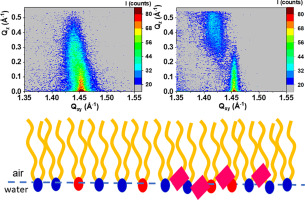Journal of Molecular Liquids ( IF 5.3 ) Pub Date : 2020-03-27 , DOI: 10.1016/j.molliq.2020.112997 Aneta Wójcik , Paulina Perczyk , Paweł Wydro , Marcin Broniatowski

|
The multi-decade worldwide application of polychlorinated biphenyls (PCB) leads to the problem of soil pollution. The production and application of PCB was banned, so the gradual decrease of their concentration in the soils was expected. On the contrary, novel sources of dichlorobiphenyls as PCB 11 were identified and these emergent pollutants are still emitted to the environment. Dichlorobiphenyls and some chlorobenzoic acids (CBA) are known as dead-end PCB metabolites – they accumulate in the soils and being toxic to microorganisms lead to the impoverishment of soil decomposer consortia. The toxicity of PCB and CBA is connected with their membrane activity and accumulation in the bacterial membranes. The correlation between the phospholipid composition of the bacterial membrane and the toxicity of PCB and CBA is unfortunately unknown limiting the effective selection of bacterial species for bioremediation of polluted soils. To shed light on these phenomena we applied binary phospholipid Langmuir monolayers as model bacterial membranes. With these models we studied the phenomena of dichlorobiphenyls and selected CBA molecules' incorporation and the effects exerted by these molecules on the ordering of the phospholipid molecules at the molecular scale. For the studies of the organization of the model membranes we applied Grazing Incidence X-ray Diffraction. It turned out that the model membranes rich in cardiolipin can accumulate more pollutant molecules than the models containing phosphatidylglycerols. The accumulation of the pollutants did not cause any significant changes in the 2D crystalline structure of the former models whereas the latter were profoundly modified.
中文翻译:

二氯联苯和氯化苯甲酸–模型细菌膜中的新兴土壤污染物。Langmuir单层膜和掠入射X射线衍射研究
多氯联苯(PCB)在世界范围的数十年应用导致了土壤污染问题。禁止生产和使用多氯联苯,因此可以预期其在土壤中的浓度会逐渐降低。相反,已确定了二氯联苯作为PCB 11的新来源,这些新兴污染物仍排放到环境中。二氯联苯和某些氯代苯甲酸(CBA)被称为无用的PCB代谢产物–它们积聚在土壤中并对微生物有毒,导致土壤分解者财团的贫困。PCB和CBA的毒性与其膜活性和在细菌膜中的积累有关。不幸的是,细菌膜的磷脂成分与PCB和CBA毒性之间的相关性是未知的,这限制了细菌种类对污染土壤进行生物修复的有效选择。为了阐明这些现象,我们将二元磷脂Langmuir单层膜用作模型细菌膜。使用这些模型,我们研究了二氯联苯的现象和选定的CBA分子的掺入以及这些分子在分子尺度上对磷脂分子有序化的影响。为了研究模型膜的组织,我们应用了掠入射X射线衍射。事实证明,与含磷脂酰甘油的模型相比,富含心磷脂的模型膜可以累积更多的污染物分子。











































 京公网安备 11010802027423号
京公网安备 11010802027423号